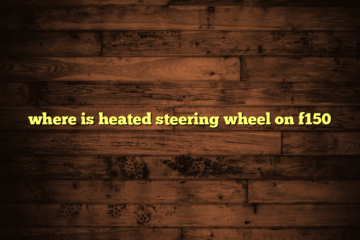What is The Difference Between 265/65r18 and 275/65r18?
When it comes to selecting tires for your vehicle, understanding the numbers and letters that define tire sizes is crucial. Two common sizes that often lead to confusion are 265/65R18 and 275/65R18. While these numbers may seem similar, they denote significant differences in tire dimensions, which can impact your vehicle’s performance, handling, and appearance. This blog post delves into the nuances of these tire sizes, helping you make an informed decision for your next tire purchase.
Introduction
Tires are a vital component of any vehicle, influencing not just the ride quality but also the safety and fuel efficiency. The numbers and letters on a tire’s sidewall represent its size, type, and performance characteristics. Understanding these metrics is key to choosing the right tire for your vehicle and driving needs. In this guide, we focus on the differences between 265/65R18 and 275/65R18 tires, two sizes that are often considered by SUV and light truck owners.
Deciphering Tire Size Notations
Before diving into the specific differences between 265/65R18 and 275/65R18 tires, let’s break down what these numbers and letters mean:
- The first three digits (265 or 275) represent the tire’s width in millimeters from sidewall to sidewall.
- The following two digits (65) indicate the aspect ratio, a percentage that reflects the height of the tire’s sidewall relative to its width.
- “R” stands for Radial, indicating the tire’s internal construction.
- The final two digits (18) denote the diameter of the wheel rim in inches that the tire is designed to fit.
Key Differences Between 265/65R18 and 275/65R18 Tires
| Feature | 265/65R18 Tires | 275/65R18 Tires |
|---|---|---|
| Width | 265 mm | 275 mm |
| Sidewall Height | Approximately 172.25 mm | Approximately 178.75 mm |
| Overall Diameter | Varies by brand/model | Slightly larger than 265/65R18, varies by brand/model |
| Fuel Efficiency | Generally good | Slightly lower due to increased rolling resistance |
| Vehicle Compatibility | Wide compatibility | Check specific vehicle fitment; may have clearance issues in tighter wheel wells |
| Handling | Good | Potentially better due to increased contact patch, but depends on tire brand/model |
| Ride Comfort | Very good | Potentially slightly better due to taller sidewall, but difference might be minimal |
| Aesthetics | Standard look | Slightly more aggressive stance due to increased width |
| Speedometer Impact | Minimal | Slight; recalibration might be necessary for accuracy |
| Suitability for Off-Road | Good | Potentially better due to wider footprint, but depends on tread pattern and tire construction |
| Tire Pressure | Refer to vehicle placard/manual | Refer to vehicle placard/manual, may vary slightly due to increased width |
| Load Capacity | Varies by tire construction and rating | Often similar, but always check specific tire ratings |
Notes:
- Overall Diameter: This can affect speedometer accuracy, vehicle dynamics, and ground clearance. The overall diameter is influenced by the tire’s width, aspect ratio, and construction, varying slightly between different tire models and brands.
- Fuel Efficiency: Wider tires like the 275/65R18 may have a slight disadvantage due to increased rolling resistance, which can affect fuel economy.
- Vehicle Compatibility: It’s crucial to ensure that the chosen tire size does not interfere with the vehicle’s suspension, brakes, or bodywork, especially during full steering lock or under full suspension compression.
- Handling and Ride Comfort: While wider tires can offer better handling due to a larger contact patch, the impact on ride comfort is generally minor and can vary depending on the specific tire design and vehicle suspension setup.
- Aesthetics: The choice between these tire sizes can also be influenced by personal preference regarding the vehicle’s appearance. Wider tires may provide a more muscular look.
- Speedometer Impact: Changing tire sizes can affect the accuracy of your vehicle’s speedometer and odometer. In some cases, recalibration may be necessary.
- Suitability for Off-Road: The tire’s suitability for off-road use will depend not just on its size but also on the tread pattern, rubber compound, and construction. Wider tires might offer better performance in certain off-road conditions due to a larger contact area.
Always consult with a tire professional or your vehicle’s manufacturer to ensure the best choice for your specific needs and driving conditions.
Width and Handling
The primary difference between these two tire sizes is their width. The 275/65R18 tire is 10mm wider than its 265/65R18 counterpart. This additional width can translate into a slightly larger contact area with the road, potentially offering better grip and handling, especially in off-road or wet conditions. However, the wider tire may also slightly increase rolling resistance, which could impact fuel efficiency.
Sidewall Height and Ride Comfort
Both tires have the same aspect ratio of 65%, but due to the difference in width, the actual sidewall height will vary slightly. The 275/65R18 tire will have a marginally taller sidewall, contributing to a minor increase in the overall diameter of the tire. This can affect ride comfort, with a taller sidewall generally providing a softer ride by absorbing more road irregularities. However, the difference might be too subtle for most drivers to notice.
Vehicle Compatibility
It’s essential to consider your vehicle’s compatibility when choosing between these tire sizes. While both are designed for 18-inch rims, the slight difference in width and overall diameter could affect how they fit in your vehicle’s wheel wells, potentially leading to rubbing issues with the 275/65R18 size in some vehicles. Always consult your vehicle’s manual or a professional to ensure proper fit.
Aesthetic Considerations
For some drivers, the choice between these tire sizes may come down to aesthetics. The wider 275/65R18 tire might provide a more aggressive, filled-out look to the wheel wells, which is a desirable trait for off-road enthusiasts and those looking to enhance their vehicle’s stance.
Conclusion
Choosing between 265/65R18 and 275/65R18 tires involves considering various factors, including handling, comfort, vehicle compatibility, and aesthetics. While the differences may seem minor, they can significantly impact your driving experience. Always refer to your vehicle’s manufacturer guidelines and consult with tire professionals to ensure the best fit for your needs.
FAQ
Can I switch from 265/65R18 to 275/65R18 without modifying my vehicle?
In many cases, yes, but it depends on your vehicle’s specific make and model. It’s crucial to consult your vehicle’s manual or a professional to ensure the larger tire size won’t cause any rubbing issues.
Will changing tire sizes affect my speedometer reading?
Yes, changing your tire size can affect the accuracy of your speedometer and odometer since these instruments are calibrated based on the factory tire size. A professional can recalibrate these instruments if necessary.
How does tire width affect fuel efficiency?
Wider tires can increase rolling resistance, which may lead to slightly lower fuel efficiency. However, the impact is often minimal and can be outweighed by the benefits in handling and grip.
Can I mix tire sizes on my vehicle?
It’s generally not recommended to mix tire sizes on your vehicle as it can affect handling, stability, and safety. Always use the same tire size on all wheel positions, unless the vehicle’s manufacturer specifically designs it for staggered tire sizes (different sizes on front and rear).
How often should I check my tire pressure?
Regardless of tire size, it’s important to check your tire pressure at least once a month and before long trips. Proper tire inflation is crucial for optimal performance, safety, and longevity.




